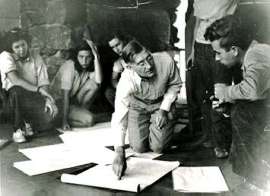
Black Mountain College
Black Mountain College was a small, experimental liberal arts college founded in 1933 in the Blue Ridge Mountains of North Carolina whose enormous influence on the arts continues up until today.

In keeping with utopian ideals of the progressive education movement, its founders regarded the study and practice of the arts as central to liberal arts education and art as a way of living and being in the world.
When prominent figures of European Modernism like Josef and Anni Albers joined the staff after fleeing to America, an interdisciplinary approach was instituted that gave equal importance to painting, weaving, sculpture, pottery, poetry, music, and dance in the curriculum. The craft principles of the Bauhaus and experimentation also became integral parts of the teaching approach. The presence of European artists and teachers like the Alberses and the de Koonings also created a cosmopolitan environment at the school, despite the rural location in the southern United States.
Learning through experience and doing, discussion and free inquiry, the sharing of ideas and values of different cultures – all were part of the educational philosophy at Black Mountain. New ways of teaching and learning were tried. Not least important, a high value was placed on individuality.
The faculty owned and administered the college, and students and faculty served on the many committees that ran it. The school functioned as a community, with everyone participating in its operation, including farm work, grounds maintenance, construction projects, and even kitchen duty.

Many prominent figures in the art world taught and studied at BMC. A partial list includes Anni and Josef Albers, John Cage, Merce Cunningham, Robert Rauschenberg, Elaine and Willem de Kooning, Buckminster Fuller, Ruth Asawa, Robert Motherwell, Robert Creeley, Cy Twombly, Kenneth Noland, Ben Shahn, Franz Kline, Dorothea Rockburne, Gwendolyn and Jacob Knight Lawrence, Charles Olson, Vera B. Williams, Arthur Penn, M.C. Richards, and Francine du Plessix Gray.
Decreasing numbers of students and mounting debts forced the school to close in 1957, but during its brief history, Black Mountain College made a contribution far out of proportion to its size to the emergence of ideas and artists that have marked the history of art.

